:::::::::::::::::::::::::::::::::::::::::::::::::::::::::::::::::::::::::::::::::::::::::::::::::::::
The Chinese background and roots of Japanese kigo
kango 漢語 words of Chinese origin
Much of Japanese culture has its roots in China.
Buddhism was first introduced around 522 via Korea and closely related to the power of the Japanese state. The Prince Shotoku Taishi 聖徳太子, born in 574, was a great promoter of State Buddhism and began to send embassies to China to study Chinese civilization in depth.
. Embassies to T'ang China 遣唐使 kentooshi .
Taking a closer look at Japanese kigo,
we realize that many have their roots in ancient Chinese poetry and painting.
Chinese poetry was widely studied by the poets of the Heian period.
And the Heian poetry had its strong influence on the poetry of the Edo period.
Not only kigo, but many themes of haiku by the old masters referre back to Chinese poetry.
Matsuo Basho was a keen student of Chinese poetry and Taoism in his youth.

Bashō and the Dao:
The Zhuangzi and the Transformation of Haikai
Peipei Qiu
- Full Text - Basho-and-the-Dao-Peipei-Qiu
- Reference -
Rhetoric and the Discourses of Power in Court Culture:
China, Europe, and Japan
David R. Knechtges
- Reference -
Sooshi 荘子 Chuang-tzu
Zhuangzi (simplified Chinese: 庄子; traditional Chinese: 莊子; pinyin: Zhuāng Zǐ; Wade–Giles: Chuang Tzŭ)
was an influential Chinese philosopher who lived around the 4th century BCE during the Warring States Period, a period corresponding to the philosophical summit of Chinese thought — the Hundred Schools of Thought, and is credited with writing—in part or in whole—a work known by his name, the Zhuangzi.
© More in the WIKIPEDIA !
. Shoomon 蕉門 Shomon - Basho's Students .
.................................................................................
tenshi o egaku 天師を画く
painting the heavenly master
. WKD - Tao, Dao and Kigo .
Dookyoo 道教 Taoism, Daoism
"Poetry Pillow words" utamakura 歌枕"
makura kotoba" 枕詞, 枕言葉
. Place names and Sooshi 荘子 .
. 風羅坊 Furabo "wind-gauze-priest" .
pen-name of Matsuo Basho
. Basho, Fukagawa and Chang-An .
造化にしたがひ 造化に帰れ
. "Follow the zooka, return to the zooka." .
. . . . . not to mix with
zoka, joka 序歌 a waka poem which is read first
. "What can I do with an old tree?" .
According to the Erh Ya (Erya),
one of the earliest Chinese dictionaries,
green is the color of spring,
red is the color of summer,
white is the color of autumn, and
black is the color of winter.
. Color symbols and haiku .
:::::::::::::::::::::::::::::::::::::::::::::::::::::::::::::::::::::::::::::::::::::::::::::::::::::
Chinese Poets and Basho
(for details check the Wikipedia)
Bai Juyi, Bo Juyi, Po Chü-i 白居易 (Haku Kyoi はく きょい)
(772–846) Po Chu-i
. Du Fu, Tu-Fu 杜甫 (To Ho と ほ).
(712 - 770)
. Hanshan and Shide 寒山拾得 Kanzan and Jittoku .
Huang Tingjiang 黄庭堅 (Koo Teiken こう ていけん)
(1045–1105)
. Li Bo, Li Po, Li Bai 李白 (Ri Haku (り はく) .
(701 - 762)
. Mozi (Mo-Tzu), Mo Di 墨子 (Bokushi) .
(460- 380 BC ?)
Su Shi 蘇軾 (So Shoku そ しょく)
Su Dongpo, Su Dungpo 蘇東坡 (So Toba そ とうば)
Dongpo Jushi (東坡居士)
(1036―1101)
. . . a Chinese writer, poet, painter, calligrapher, pharmacologist, gastronome, and a statesman of the Song Dynasty (960–1279).
© More in the WIKIPEDIA !
. Chinese learning 漢学 kangaku
study of the Chinese classics .
:::::::::::::::::::::::::::::::::::::::::::::::::::::::::::::::::::::::::::::::::::::::::::::::::::::
. Confucius 孔子 Kooshi, Koshi .
Koofuushi 孔夫子, Kung Tzu, Kung Fu Tzu, Kung Fu Zi, Kǒng fū zǐ.
also called
Sekiten 釈奠 or Sekisai 釈菜
Confucius and kigo
:::::::::::::::::::::::::::::::::::::::::::::::::::::::::::::::::::::::::::::::::::::::::::::::::::::
ーーーーー Chinese Poetry Anthologies available at the time of Basho
Gu wen zhen bao 古文真宝 True treasures of ancient literature
Kinshû dan 錦 繍段 Collection of Brocade Pieces
Lian zhu shi ge 聯珠詩格 Strings of pearls:
A classified selection from Tang and Song poets.
San ti shi 三体詩 Poems of three forms
Shiren yu xie 詩人玉屑 Gemlike words of poets
Yuan ji huo fa shixue quanshu 圓機活法詩學全書
Practical knacks and workable methods: An encyclopedia of poetics
Shiren yu xie:
Under the title “Dwelling in Retirement,” for instance, the book cites Tao Qian as an example under “Historical Facts” and provides 168 couplets by poets from different periods; some of them directly mention the names of Ruan Ji, Ji Kang, and Tao Qian.
The entry also gives twenty-six “Related Images and Motives,” such as “composing a poem,” “study surrounded by bamboos,” “bamboo groves,” “thatched hut,” “sitting in tranquility,” “lonely and tranquil,” “remote place,” “playing the zither,” “purity and loftiness,” and “drinking wine.”
source : Basho-and-the-Dao - Peipei-Qiu
The Influence of Chinese Literature on Basho
source : Bill Wyatt - - -
:::::::::::::::::::::::::::::::::::::::::::::::::::::::::::::::::::::::::::::::::::::::::::::::::::::
Many Japanese festivals have their roots in Chinese festivals too.
Festivals on days with a double prime number
First day of the first lunar month
. New Year 正月 shoogatsu .
Third day of the third lunar month
. Hina Doll Festival 雛祭り hina matsuri .
Fifth day of the fifth lunar month
. Boys' Festival 端午節句 tango no sekku .
Seventh day of the seventh lunar month
. Star Festival 七夕 Tanabata .
Ninth day of the ninth lunar month
. Chrysanthemum Festival 重陽 chooyoo .
chooyoo 重陽 (ちょうよう) "double prime number nine"
..... chookyuu 重九(ちょうきゅう)"double nine"
Double Nine Day
According to Chinese customs,
the first six days of January were dedicated to animals and the last day of the week to man.
January 7 : 7日を人の日 day of man (jinjitsu 人日)
. five seasonal festivals 五節句 gosekku .
.................................................................................
Buddhist festivals can be traced back to various roots in Asia.
. Saijiki for Buddhist Festivals .
The various kigo will not be listed here.
.................................................................................
. Kobayashi Issa 小林一茶 and Chinese roots .
I will try and collect kigo with a Chinese influence here.
under construction
:::::::::::::::::::::::::::::::::::::::::::::::::::::::::::::::::::::::::::::::::::::::::::::::::::::

source : mariko789.exblog.jp
春節の赤あざやかに中華街
shunsetsu no aka azayaka ni chuukagai
the bright red
of the spring festival -
Chinatown
Nagareboshi 流星
shunsetsu refers to the Chinese New Year celebrations.
春節 = 中国正月
. Shunsetsu-sai 春節祭 Spring Festival .
Celebrated in Chinatown, Kobe.
:::::::::::::::::::::::::::::::::::::::::::::::::::::::::::::::::::::::::::::::::::::::::::::::::::::
Kigo related to the Asian lunar calendar
72 seasons, seasonal points
shichijuuni koo, shichinuniko 七十二候(しちじゅうにこう)
Shichijūni kō
. Asian calendar-related kigo .
:::::::::::::::::::::::::::::::::::::::::::::::::::::::::::::::::::::::::::::::::::::::::::::::::::::
春山は淡治にして笑うが如く、
夏山蒼翠(そうすい)にして滴(したた)るが如く、
秋山明浄(めいじょう)にして粧(よそお)うが如く、
冬山惨淡(さんたん)にして眠るが如し
The mist around the mountains is not the same at the four seasons.
The mountains in spring are light and seductive as if smiling:
the mountains in summer have a blue-green colour
which seems to be spread over them;
the mountains in autumn are bright and tidy as if freshly painted;
the mountains in winter are sad and tranquil as if sleeping.
. WKD : Mountains alive in all seasons .
:::::::::::::::::::::::::::::::::::::::::::::::::::::::::::::::::::::::::::::::::::::::::::::::::::::
kigo (and some keywords) with Chinese roots
. Banana leaf 芭蕉葉 bashooba .
Zhang Hengqu (1020-1077) and Huaisu (725-785)
. Beard 髭 hige .
Du Fu 杜甫
. biwa 琵琶 Biwa lute . and Biwakoo琵琶行 Biwako
. Butterfly 蝶々 choochoo .
and the Chinese sage Chunag-Tsu (Chunag Tzu, Zhuangzi).
Sooshi 荘子 Soshi
. Carp 鯉 koi .
carp streamers 鯉幟 koi nobori
. Cherry Blossoms 桜 sakura .
. Cotton Bow 綿弓 watayumi, wata yumi .
. Crane 鶴 tsuru .
. Dragon, climbing to heaven 龍天に登る ryuu ten ni noboru .
and more Dragon Haiku
. Draining the riece paddies 水落す mizu otosu .
. Firework display 花火 hanabi .
Frog and Cicada 蛙鸣蝉噪 wa ming chan zao
. Frost, frost on the grass 草の霜 kusa no shimo .
. Fujisan, Fuji san 富士山 Mount Fuji .
. Gourd 瓢箪 hyootan .
. Kite 鳶 tombi .
and Liezi "riding the wind"
. Medicine and ritual ricewine 屠蘇 toso .
yakuzen, yaku-zen 薬膳 "Eating Medicine"
. Millipede 蜈蚣 . 百足虫 mukade .
. Mole 偃鼠 enso, mogura .
. Moon 月 tsuki .
. Mulberry 椹 kuwa no mi .
. Paulownia, one leaf 桐一葉 kiri hitoha .
. Peony 牡丹 botan .
princess Yoki-Hi 楊貴妃 Yang Guifei
. pigweed 藜 / アカザ akaza .
and the cane for long life, akaza no tsue 藜の杖
. Plum blossom 梅 ume .
. Rosei 廬生 Lu Sheng (713 - 741) and his dream .
. Rose of Sharon 木槿 mukuge .
. Swing 鞦韆 秋韆 buranko .
yusahari ゆさはり、hanzengi 半仙戯
. Tofu, bean curd 豆腐 toofu, dofu .
. Warriours of old 強者 tsuwamono .
and the ruins of Hiraizumi
. Waterfall 滝 taki .
Basho remembering 酒仙人李白
. Willow tree 柳 yanagi .
. Wind - kaze no oto 風の音 the sound of wind .
:::::::::::::::::::::::::::::::::::::::::::::::::::::::::::::::::::::::::::::::::::::::::::::::::::::
Topics for Haiku
. Temple Manpukuji 万福寺、Uji, Kyoto .
and
fucha ryori 普茶料理 the Chinese-style Buddhist vegetarian cuisine
The Seven Sages of the Bamboo Grove
The Seven Worthies of the Bamboo Grove
. Takeyabu 竹薮 bamboo grove .
. Sakazuki 盃 small cup for ricewine .
and
koyoi no tsuki 今宵の月 the moon tonight
:::::::::::::::::::::::::::::::::::::::::::::::::::::::::::::::::::::::::::::::::::::::::::::::::::::
Confucian principles, the five virtues , Five Constants
wuchang 五常の徳 Die fünf Tugenden
ren 仁 jin - Humaneness, Menschlichkeit
yi 義 gi - Righteousness, Gerechtigkeit
li 礼 /禮 rei - Propriety or Etiquette, Ethisches Verhalten
zhi 智 chi - wisdom, Weisheit
xin 信 shin - faithfulness, Integrity, Güte
- - - - - and the four virtues:
Zhong 忠, Loyalty
Xiao 孝, Filial piety
Jie 節, Continency
Yi 義, Righteousness.
. How Western translations
distort China's reality .
*****************************
Related words
. Japanese Kigo 季語 .
. Seasons and Categories . Haiku
. History of Japanese Saijiki 歳時記 .
. Matsuo Basho - Archives of the WKD .
[ . BACK to WORLDKIGO . TOP . ]
:::::::::::::::::::::::::::::::::::::::::::::::::::::::::::::::::::::::::::::::::::::::::::::::::::::



























